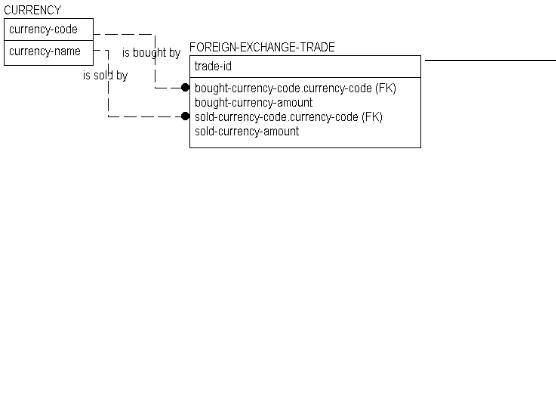
- •Contents
- •Preface
- •Intended Audience
- •About this Guide
- •Typographical Conventions
- •Related Documentation
- •What’s In This Chapter?
- •Chapter Contents
- •What is Data Modeling?
- •Data Modeling Sessions
- •Session Roles
- •Sample IDEF1X Modeling Methodology
- •Logical Models
- •The Entity Relationship Diagram
- •The Key-Based Model
- •The Fully-Attributed (FA) Model
- •Physical Models
- •The Transformation Model
- •The DBMS Model
- •Benefits of Modeling in ERwin
- •What’s In This Chapter?
- •Chapter Contents
- •The Entity-Relationship Diagram
- •Defining Entities and Attributes
- •Logical Relationships
- •Many-to-Many Relationships
- •Validating the Design of the Logical Model
- •Data Model Example
- •What’s In This Chapter?
- •Chapter Contents
- •Understanding Keys
- •Selecting a Primary Key
- •Designating Alternate Key Attributes
- •Inversion Entry Attributes
- •Relationships and Foreign Key Attributes
- •Dependent and Independent Entities
- •Identifying Relationships
- •Non-Identifying Relationships
- •Rolenames
- •What’s In This Chapter?
- •Chapter Contents
- •Naming Entities and Attributes
- •Synonyms, Homonyms and Aliases
- •Entity Definitions
- •Descriptions
- •Business Examples
- •Comments
- •Definition References and Circularity
- •Constructing a Business Glossary
- •Attribute Definitions
- •Rolenames
- •Definitions and Business Rules
- •What’s In This Chapter?
- •Chapter Contents
- •Relationship Cardinality
- •Cardinality in Non-Identifying Relationships
- •Referential Integrity
- •Reading Referential Integrity Options
- •RI, Cardinality, and Identifying Relationships
- •RI, Cardinality, and Non-Identifying Relationships
- •Additional Relationship Types
- •Many-to-Many Relationships
- •N-ary Relationships
- •Recursive Relationships
- •Subtype Relationships
- •Complete Versus Incomplete Subtype Structures
- •Inclusive and Exclusive Relationships
- •IDEF1X and IE Subtype Notation
- •When to Create a Subtype Relationship
- •Introduction
- •Chapter Contents
- •Overview of the Normal Forms
- •Functional Dependence (FD)
- •Full Functional Dependence
- •First Normal Form (1NF)
- •Second Normal Form (2NF)
- •Third Normal Form (3NF)
- •Common Design Problems
- •Repeating Data Groups
- •Multiple Use of the Same Attribute
- •Multiple Occurrences of the Same Fact
- •Conflicting Facts
- •Derived Attributes
- •Missing Information
- •Unification
- •How Much Normalization Is Enough?
- •Conclusions
- •ERwin Support for Normalization
- •First Normal Form Support
- •Second and Third Normal Form Support
- •What’s In This Chapter?
- •Chapter Contents
- •Creating a Physical Model
- •Denormalization
- •Classification of Dependent Entities
- •Glossary of Terms
- •Index
- •Documentation Comments Form

ERwin Methods Guide |
4 |
|
|
Attribute Definitions
As with entities, it is important to define all attributes clearly. The same rules apply — by comparing a thing to a definition, we should be able to tell if it fits. However, you should beware of things like “account-open-date” defined as, “The date on which the ACCOUNT was opened.” You may need to further define what is meant by “opened” before the definition is clear and complete.
Attribute definitions generally should have the same basic structure as entity definitions, including a description, examples, and comments. The definitions should also contain, whenever possible, rules that specify which facts are accepted as valid values for that attribute.
A validation rule identifies a set of values that an attribute is allowed to take, it constrains or restricts the domain of values that are acceptable. These values have meanings in both an abstract and a business sense. For example, “person-name,” if it is defined as the preferred form of address chosen by the PERSON, is constrained to the set of all character strings. You can define any validation rules or valid values for an attribute as a part of the attribute definition. ERwin also lets you assign these validation rules to an attribute using a domain. Supported domains include text, number, datetime, and blob.
Definitions of attributes, such as codes, identifiers, or amounts, often do not lend themselves to good business examples. So, including a description of the attribute’s validation rules or valid values is usually a good idea. When defining a validation rule it is good practice to go beyond listing the “values” that an attribute can take. Suppose we define the attribute “customer-status” as follows:
Customer-status: A code that describes the relationship between the CUSTOMER and our business. Valid values: A, P, F, N
The validation rule specification is not too helpful because it does not define what the codes mean. You can better describe the validation rule using a table or list of values, such as the one below:
Valid Value |
Meaning |
A: Active |
The CUSTOMER is currently involved in a purchasing relationship |
|
with our company. |
P: Prospect |
Someone with which we are interested in cultivating a relationship, but |
|
with whom we have no current purchasing relationship. |
F: Former |
The CUSTOMER relationship has lapsed — i.e., there has been no |
|
sale in the past 24 months. |
N: No business accepted The company has decided that no business will be done with this CUSTOMER.
Naming and Defining Entities and Attributes ∙ 43

4 |
ERwin Methods Guide |
|
|
Rolenames
When a foreign key is contributed to a child entity through a relationship, you may need to write a new or enhanced definition for the foreign key attributes that explains their usage in the child entity. This is certainly the case when the same attribute is contributed to the same entity more than once. These duplicated attributes may appear to be identical, but because they serve two different purposes, they cannot have the same definition.
Consider the example below. Here we see a FOREIGN-EXCHANGE-TRADE with two relationships to CURRENCY.
Currency Example
The key of CURRENCY is “currency-code,” (the identifier of a valid CURRENCY that we are interested in tracking). We see from the relationships that one CURRENCY is “bought by,” and one is “sold by” a FOREIGN- EXCHANGE-TRADE.
We see also that the identifier of the CURRENCY (the “currency-code”) is used to identify each of the two CURRENCYs. The identifier of the one that is bought is called “bought-currency-code” and the identifier of the one that is sold is called “sold-currency-code.” These rolenames show that these attributes are not the same thing as “currency-code.”
44 ∙ Naming and Defining Entities and Attributes

ERwin Methods Guide |
4 |
|
|
It would be somewhat silly to trade a CURRENCY for the same CURRENCY at the same time and exchange rate. Thus, for a given transaction (instance of FOREIGN-EXCHANGE-TRADE) “bought-currency-code” and “sold- currency-code” must be different. By giving different definitions to the two rolenames, we can capture the difference between the two currency codes.
Attribute/Rolename |
Attribute Definition |
currency-code |
The unique identifier of a CURRENCY. |
bought-currency-code |
The identifier (“currency-code”) of the CURRENCY bought by |
|
(purchased by) the FOREIGN-EXCHANGE-TRADE. |
sold-currency-code |
The identifier (“currency-code”) of the CURRENCY sold by the |
|
FOREIGN-EXCHANGE-TRADE. |
|
|
The definitions and valididations of the bought and sold codes are based on “currency-code.” “Currency-code” is called a base attribute.
IDEF1X standard dictates that if two attributes with the same name migrate from the same base attribute to an entity, that the attributes must be unified. The result of unification is a single attribute migrated through two relationships. Because of the IDEF1X standard, ERwin automatically unifies foreign key attributes, as well. If you do not want to unify migrated attributes, you can rolename the attributes at the same time that you name the relationship, in ERwin’s Relationship Editor.
Naming and Defining Entities and Attributes ∙ 45

4 |
ERwin Methods Guide |
|
|
Definitions and Business Rules
Business rules have been mentioned earlier as an integral part of the data model. These rules take the form of relationships, rolenames, candidate keys, defaults, and other modeling structures not yet explored, including generalization categories, referential integrity, and cardinality. And, business rules are also captured in entity and attribute definitions and validation rules.
For example, the CURRENCY entity in the previous figure could be defined either as the set of all valid currencies recognized anywhere in the world, or could be defined as the subset of these which our company has decided to use in its day to day business operations. This is a subtle, but important distinction. In the latter case, there is a business rule, or “policy statement,” involved.
This rule manifests itself in the validation rules for “currency-code.” It restricts the valid values for “currency-code” to those that are used by the business. Maintenance of the business rule becomes a task of maintaining the table of valid values for CURRENCY. To permit or prohibit trading of CURRENCYs, you simply create or delete instances in the table of valid values.
The attributes “bought-currency-code” and “sold-currency-code” are similarly restricted. And both are further restricted by a validation rule that says “bought-currency-code” and “sold-currency-code” cannot be equal – so each is dependent on the value of the other in its actual use. Using ERwin, validation rules can be addressed in the definitions of attributes, and can also be defined explicitly using validation rules, default values, and valid value lists.
46 ∙ Naming and Defining Entities and Attributes
